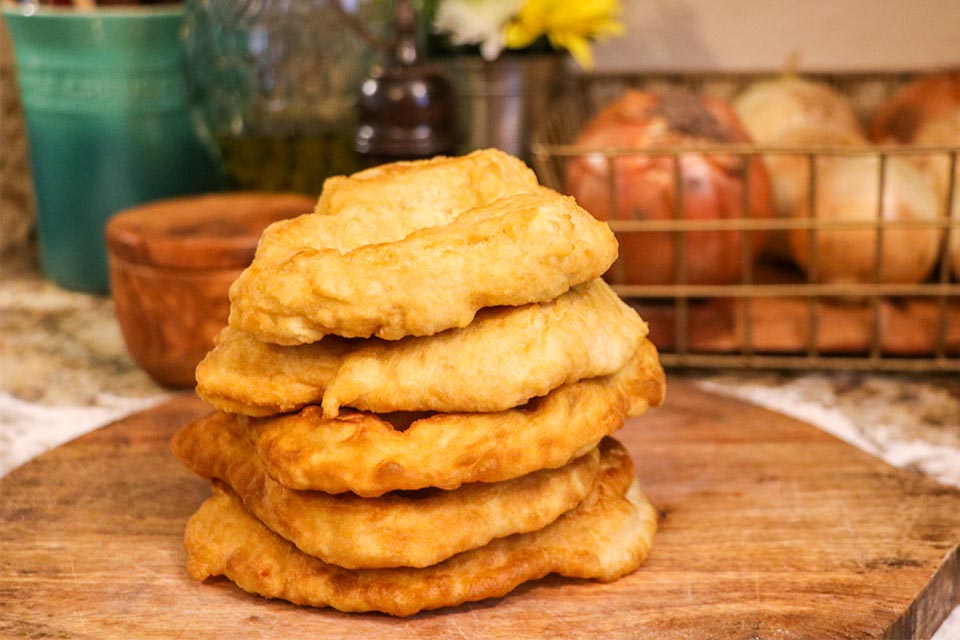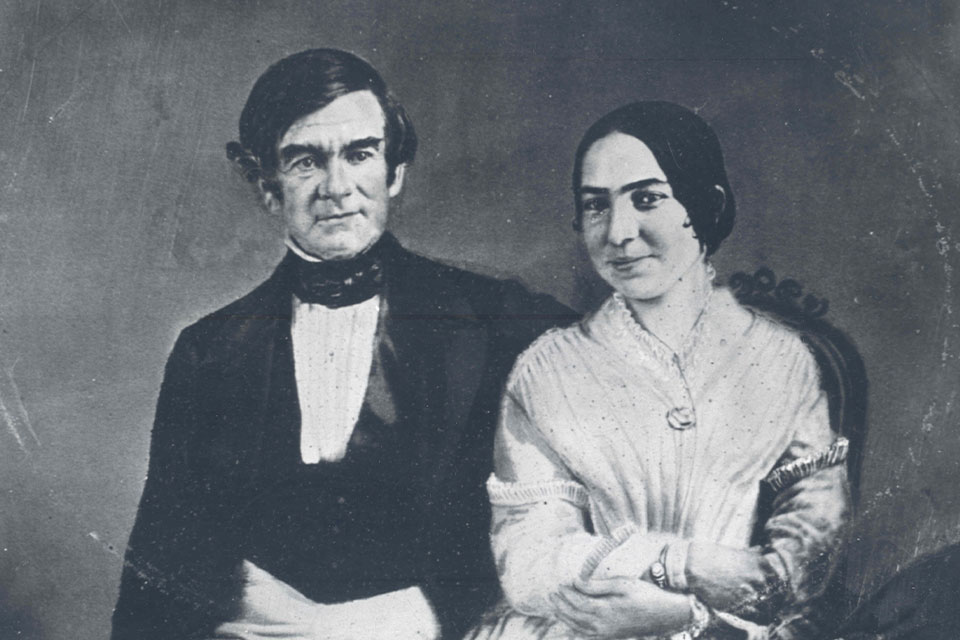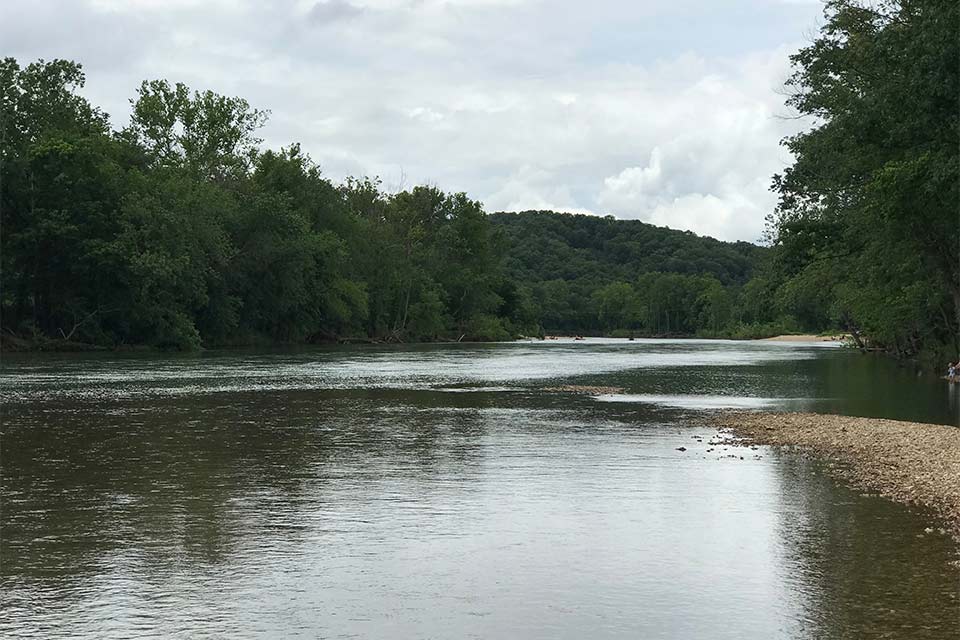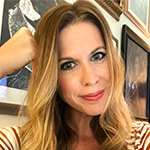Born and Bread: A Native American Tale

Desperately wanting to find a space to further her relationship with Native American food culture, a writer travels to Tahlequah, Oklahoma, thinking it might hold the key.
On our way to Tahlequah, I saw rivers give way to trees and lakes rolling out in a glittering expanse on either side. True, it wasn’t much different from the usual Texas scenery, but I felt the shift in my bones. I hadn’t been back to the Cherokee Nation since I was a child.
What I’ve come to know about my Cherokee heritage is mostly filtered down through tales told by my aunt Gayle, a Native storyteller who lives in Tahlequah. When I was in elementary school, she would visit for storytelling events in the library, and I was always proud watching my classmates become transfixed by her voice and wondrous stories of the Cherokee people. Her hands move while she speaks as if she’s painting the words in the air. To this day, she can hold anyone in a trance whether she is spinning beautiful Native stories or recounting headlines from the news.
In my memory, the stories are many but distant like birds circling overhead. I spent years enthralled by Native legends, a connection that felt special yet somehow like a living thing I couldn’t quite capture. There is the story of a girl who falls so deeply in love with the moon that she climbs up into the night sky to be with him, and another about Cherokee children riding the backs of turtles into the sea. In those times of retelling, my aunt would often revisit the memories and life of John Ross, the principal chief for almost forty years who led the Trail of Tears after the Indian Removal Act was signed in 1830. He also happens to be my fourth-great-grandfather. Yes, four “greats” that I often quickly and discreetly count on my hands when I tell people this fact.
John Ross married my fourth-great-grandmother, Elizabeth Henley or “Quatie,” who was half Cherokee. Over decades removed, I am holding a portion of the blood that flowed through each generation. However, my northern European ancestry dominated my genes, giving me light-blue eyes and fair skin. This is made more obvious in the stark contrast to my mom and aunt, with their bronzed complexion staying year-round and deep chestnut eyes. My aunt, though, has flecks of gold and green in her eyes that catch the light as she speaks and the rounded cheekbones of her father, my grandfather, also named John Ross. And if anyone asks about her percentage of Cherokee blood, I’ve heard her reply, You can do the math.
While my appearance has often betrayed my sense of Cherokee belonging, a gentle reminder came in a gift from my husband just after we got married in 2019: a DNA testing kit encouraging me to rediscover this identity. When the results arrived there it was, in a small but not insignificant percentage: Indigenous American. It was like dipping a honeycombed pan into a stream and praying for gold. Really, it’s strange to think that you can capture the tiny blueprint of our bodies and hold it up to the light. This was something that lived in me; this was real.

Really, it’s strange to think that you can capture the tiny blueprint of our bodies and hold it up to the light.
* * *
So, on this four-hour journey north from Dallas with my mom, husband, and eighteen-month-old daughter, I stare intently at the landscape as we approach Tahlequah. Silently, I start to erase the buildings that flank the road and imagine what it must have been like two hundred years ago. Small cliffs leaning into a mass of trees, the Illinois River splitting the land with her broad stretch of silver.
We were en route to a house I’d secured for the weekend just a few blocks from Muskogee, the main avenue running through downtown. Somewhere mid-drive I began my research on what has always planted my heart firmly in any experience: food. I desperately wanted to find a space to further my relationship with Native American food culture and thought Tahlequah might hold the key.
In 2022 my husband and I, along with my daughter (the size of a lemon growing deep in my belly), took a trip to Minneapolis where our three-day and four-state road trip would begin. Our last night in town, after a whirlwind tour of the Dakotas and Iowa, we were back in the Twin Cities. With a pleading phone call, I was able to book a last-minute 5:30 p.m. reservation at James Beard Award–winning restaurant Owamni, which showcases Indigenous food through a “decolonized lens.” We dined on crab-and-corn dumplings, elk, and wild rice sorbet. Each carefully curated plate was in itself a whole experience, and the harmony of ingredients paired with the history and intention made for an unforgettable evening. The meal was punctuated by a conversation with Chef Sean Sherman himself, a member of the Oglala Lakota Sioux tribe. After discovering I was Cherokee, he said, “We have to keep our culture alive, don’t we? We have to keep trying.” We.
* * *
Our drive to Tahlequah had, so far, only provided one failed attempt to stop at a fry bread joint off Highway 75, which was closed. We ended up settling for a couple of corn dogs at a drive-in next door—not exactly the culinary kickoff I’d had in mind. Fry bread, a staple of modern Native American food, has its painful origin in Navajo history. It is said that during the Long Walk (the devastating sister of the Trail of Tears), fry bread was born in the face of oppression and colonization. The US government rationed staple items to the Navajo people, and to avoid starvation, a simple bread was created in the midst of unimaginable hardship. This cloudlike bread usually consists of flour, water, salt, and some sort of oil or lard. Modern adaptations sometimes include baking powder or yeast, but as my aunt says, Everyone argues over the best way to make it. The painful narrative behind fry bread makes for a troublesome division over its place in Native American cuisine. Still, it represents a resilience in Indigenous people, often appearing at powwows and other tribal gatherings. Upon my arrival in Tahlequah, I had still never eaten fry bread.
The painful narrative behind fry bread makes for a troublesome division over its place in Native American cuisine.
We arrived at our cottage at the edge of downtown on the tail end of a storm that turned the landscape ethereal, both glistening and green. I hadn’t seen my aunt in years, but when she pulled up I recognized the same warm eyes that crinkle at their edges and long, dark ponytail falling down her back. With beautifully beaded earrings, she always exuded the energy of something pulled directly from the earth—like water, or forest. The next day started early at the Cherokee National History Museum, where my aunt and I would walk side by side through the past, me listening while she recaptured each event in perfect cadence, the smooth lilt of her voice just like I remembered as a child. In front of one painting, she told the tale of the Three Sisters, which represent the main crops of Indigenous people: corn, squash, and beans. She explained how these vegetables work together like family, nourishing one another under the soil and providing the other sisters with nutrients.

On the way back to the cottage, we took a small detour into the local gift shop. I bought earrings made with cut stones the color of morning sky and then found a small book tucked away on the shelf titled American Indian Cooking and Herb Lore, by J. Ed Sharpe and Thomas B. Underwood. With the book under my arm and a plush wolf for my daughter, we returned to meet the others. In a tone that indicated my aunt was about to impart her wisdom, we listened as she explained the meaning behind the seven Cherokee clans: Long Hair, Wolf, Paint, Deer, Wild Potato, Bird, and Blue. “The clans are matriarchal,” she said, “passed down from your mother.” She told us how, since their mother was white, it had to come from Ann—their grandmother. “We are Wolf Clan,” she said, placing the little wolf in my daughter’s hands. “We are known for protection and for looking after our family. That’s what we’re really about—family.” Waya, she said—Cherokee for wolf, and I watched the eyes of my daughter glitter as she buried her small face into the fur.
Later that afternoon, I went across town with my mom and aunt to the cemetery where we visited the burial sites of John Ross and Ann, my great-grandmother. On a hill that overlooked a wheat-colored sprawl of land, the cliffs rising up just beyond, we walked the patch of grass where so many of my ancestors were at rest. Some stones colored with moss and small sprays of flowers punctuated a few of the graves. We stood like that, the three of us women surrounded by those that came before—separated by decades and hundreds of miles, yet in this singular moment here together.
Eventually the hours spun themselves into dusk, the final peach-pink light of day falling over the trees. My aunt and mom sat on the couch reminiscing about the wild adventures of childhood, scraped knees, and riding bareback after school. When our daughter, tucked in bed with her small wolf, was finally asleep, my husband and I slipped out to Muskogee Avenue to walk the darkened streets of the main drag and find a place to grab a drink or a bite to eat. His arm slung around my shoulders, we enjoyed the few bars that dotted our path on a sleepy Saturday night. I watched women with thick, dark braids falling on their shoulders clink beers while we finished our drinks by an outdoor fireplace before tumbling back into the night. Suddenly, a white, unmarked food truck appeared in small parking lot fully illuminated by a streetlight in an otherwise darkened space. The words “Indian Taco” were glowing on his menu board with protein options listed underneath. I ordered one Indian taco with beef from the nice-looking man working alone inside the truck. It was called Drake’s, I came to find out, owned and operated by Kyle Drake, a local downtown bartender.
After I ordered, I watched the assembly of my Indian taco, which began, to my surprise, with an entire piece of fluffy fry bread torn up and used as the base layer. From there the beef was spooned over top and then some familiar additions—tomato, cheese, onions, lettuce—all piled in what would fill an entire takeaway box. Arms now full of my one Indian taco and impossibly hungry, my husband and I walked to the nearest bench under a small tree. Peeling back the lid, plastic fork in hand, knees as a table, I took the first pillowy bite of fry bread. A light crispiness encased the otherwise soft, spongy morsels. Perfectly soaking up each bit of sauce, an ideal vessel to pair with each bite of beef and toppings. A simple bread in theory with a rich past and a difficult story—the heaviness of this history now reimagined on a street corner in Tahlequah. I watch the line of people stretch far from the modest window of Drake’s as laughter erupts among groups waiting for their orders to arrive. Music spills from the door of Ned’s, a popular hangout, while a few young women emerge, hair pouring down their backs. Some of them are still dancing, swaying, and whirling, as they move their way up the street.
* * *
Back home in Dallas, now in my own kitchen, I pull the small Indian cookbook from my bag. Leafing through the pages filled with Native recipes—Old-Fashion Squirrel Stew, Batter-Fried Squash Blossoms, and Cherokee Yam Cakes—a humble bread recipe catches my eye. I read flour, baking powder, salt, milk . . . fry the bread in about ¼” hot cooking oil. Smiling in recognition, daughter playing close by on the floor, I draw open the cabinet knowing that somewhere I have exactly what I need.
Dallas











